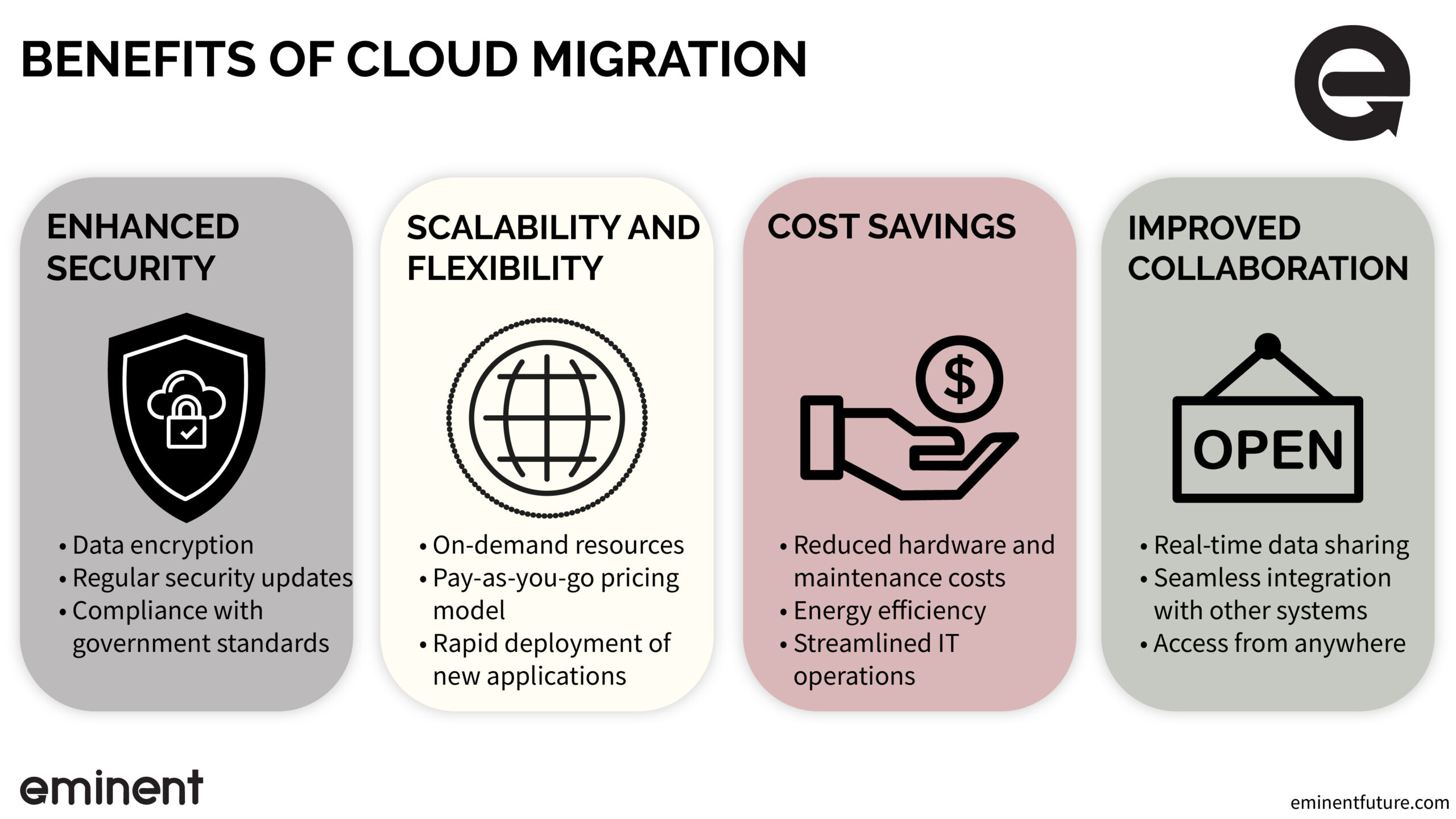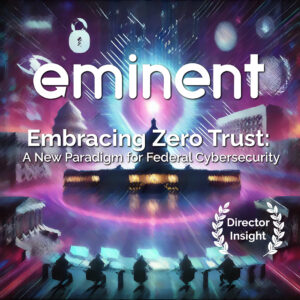
The digital landscape constantly evolves, and federal agencies must adapt. One essential step in modernizing government operations is migrating legacy systems to a secure cloud infrastructure.
This transition enhances security and data protection and improves scalability, flexibility, and collaboration, resulting in cost savings and reduced maintenance. This article will explore the benefits, key steps, challenges, and best practices for migrating legacy systems to modern, secure clouds. Additionally, we will discuss the importance of evaluating and selecting the right cloud service providers to ensure robust security measures and compliance with federal regulations.
Benefits of Migrating to a Modern, Secure Cloud

Migrating legacy systems to a modern, secure cloud infrastructure offers numerous benefits to federal agencies, driving improvements in various aspects of their operations.
Enhanced security and data protection
One of the most significant advantages of moving to a secure cloud environment is the enhanced security and data protection it provides. Cloud service providers offer robust security measures that are continuously updated to protect against emerging threats.
This includes advanced encryption, intrusion detection, and secure access controls, ensuring the confidentiality, integrity, and availability of sensitive government data. By leveraging the security expertise of cloud providers, federal agencies can safeguard their critical information assets more effectively than with on-premises legacy systems.
Improved scalability and flexibility
Migrating to a modern, secure cloud enables federal agencies to achieve greater scalability and flexibility in their IT infrastructure. Cloud-based systems can be quickly scaled up or down to accommodate changing demands, allowing agencies to respond more efficiently to evolving needs.
This adaptability is particularly valuable for government organizations, which often experience fluctuations in workload and resource requirements. The cloud also offers the ability to deploy new applications and services rapidly, helping agencies stay agile and adapt to changing mission objectives.
Cost savings and reduced maintenance
Transitioning from legacy systems to a cloud-based infrastructure can result in significant cost savings for federal agencies. Cloud services typically operate on a pay-as-you-go model, which allows organizations to pay only for the resources they consume.
Such structures reduce the need for upfront capital investments and help control operational expenses. Additionally, the maintenance burden associated with on-premises systems is shifted to the cloud provider, reducing the time and resources needed for hardware upkeep, software updates, and troubleshooting. This enables agencies to focus their resources on mission-critical tasks rather than IT maintenance.
Streamlined collaboration and data sharing
Migrating to a modern, secure cloud environment can also improve collaboration and data sharing among federal agencies. Cloud-based platforms facilitate seamless access to data and applications from anywhere and at any time, enabling employees to work more efficiently and share information quickly.
This enhanced collaboration can lead to better decision-making and improved coordination between different departments and agencies, ultimately enhancing the overall effectiveness of federal operations.
Critical Steps in Migrating Legacy Systems to the Cloud

Successfully transitioning from legacy systems to a modern, secure cloud infrastructure requires careful planning and execution. Here are the key steps federal agencies should follow when migrating their IT systems to the cloud:
Assessing the current infrastructure
Before beginning the migration process, assessing the current IT infrastructure is essential to understand the agency’s specific requirements, challenges, and opportunities. Auditing current infrastructure involves conducting a thorough inventory of existing hardware, software, and network components and evaluating their performance, security, and compatibility with cloud-based solutions.
Identifying pain points and potential areas for improvement will help agencies determine their migration goals and establish the right cloud strategy.
Identifying suitable cloud providers and solutions
Next, federal agencies must identify suitable cloud providers and solutions that align with their specific needs and objectives. This process involves researching and evaluating various cloud offerings, considering security, compliance, performance, and cost factors.
Agencies should also consider their sector’s specific requirements, such as adherence to government regulations and standards. Selecting the right cloud provider and solution is crucial for a successful migration and ensuring the long-term success of the cloud-based infrastructure.
Developing a migration plan
Once an agency has decided on an appropriate cloud provider and solution, it’s time to develop a comprehensive migration plan. This plan should outline the steps, timeline, and resources required for the migration process, considering data migration, application re-architecture, and infrastructure setup.
The plan should also establish clear roles and responsibilities for the migration team, ensuring that all stakeholders are aligned and working together effectively.
Executing the migration process
Federal agencies can begin migrating their legacy systems to the cloud with a solid migration plan. The migration may involve moving data, applications, and infrastructure components to the new environment and making necessary adjustments to ensure optimal performance and security.
Throughout the migration process, it’s essential to maintain clear communication with stakeholders, provide regular updates, and address any issues that may arise.
Ongoing monitoring and optimization
After the migration is complete, ongoing monitoring and optimization are critical to ensuring the continued success of the new cloud-based infrastructure. Federal agencies should establish processes for monitoring performance, security, and compliance and implement regular updates and improvements.
This ongoing optimization helps agencies maximize the benefits of their cloud-based systems, ensuring they continue to meet evolving needs and deliver the best possible services to their constituents.
Challenges and Considerations in Cloud Migration

While migrating legacy systems to the cloud offers many benefits, federal agencies face several challenges and considerations. Addressing these concerns is essential to ensure a successful and seamless transition.
Security and compliance concerns
One of the main challenges in cloud migration is addressing security and compliance concerns. Federal agencies must ensure the chosen cloud provider meets strict security standards and adheres to relevant government regulations.
To guarantee this, agencies must assess the provider’s security measures, such as encryption, access controls, and incident response procedures, and ensure compliance with applicable laws and industry standards.
Legacy system compatibility issues
Compatibility issues can complicate migrating legacy systems to the cloud. Older hardware and software may need to be more readily compatible with cloud-based solutions, requiring modifications or replacements to ensure seamless integration.
Federal agencies must carefully assess their existing systems and work closely with cloud providers to identify potential compatibility issues and develop solutions.
Data migration and integration challenges
Transferring large volumes of data from legacy systems to the cloud can be complex and time-consuming. Federal agencies must plan for potential data migration challenges, such as data loss, corruption, or misconfiguration.
Developing a robust data migration strategy and utilizing tools and services to streamline the process can help agencies overcome these challenges and ensure a smooth transition.
Employee training and change management
Migrating to the cloud often involves adopting new processes, technologies, and workflows, which can present challenges for employees accustomed to legacy systems. Federal agencies must invest in employee training and change management initiatives to ensure a successful migration.
This process includes providing resources, support, and guidance to help staff adapt to the new cloud-based environment and maximize its benefits. Clear communication and ongoing engagement are essential to addressing employee concerns and fostering a positive transition to the cloud.
Best Practices for a Successful Cloud Migration

To ensure a smooth and successful migration of legacy systems to a modern, secure cloud environment, federal agencies should consider the following best practices:
Collaborating with experienced cloud service providers
Working closely with professional cloud service providers can help federal agencies navigate the complexities of cloud migration. These providers can offer invaluable guidance, support, and resources throughout the migration process, ensuring a seamless transition to the cloud.
Establishing a clear migration timeline and objectives
Creating a detailed migration timeline and setting clear goals is crucial for successful cloud migration. Federal agencies should outline each phase of the migration process, including assessment, planning, execution, and optimization.
Clearly defined goals and milestones can help agencies stay on track and measure progress throughout the migration.
Ensuring adequate employee training and support
As mentioned earlier, employee training and support are essential to successful cloud migration. Federal agencies should invest in comprehensive training programs, workshops, and educational resources to empower their workforce with the skills and knowledge required to utilize the new cloud environment effectively.
Implementing robust security measures
Migrating to the cloud requires implementing robust security measures to protect sensitive data and maintain compliance with government regulations. Federal agencies should work closely with their cloud provider to ensure that appropriate security controls are in place, including encryption, access management, and incident response procedures.
Continuously monitoring and optimizing the cloud environment
Once the migration is complete, federal agencies should wait to consider the process finished. Continuous monitoring and optimization of the cloud environment are essential to maintain peak performance, security, and efficiency.
Agencies should establish regular monitoring protocols, review performance metrics, and proactively address potential issues to ensure their cloud environment remains secure, optimized, and aligned with their objectives.
Evaluating Cloud Service Providers

Several cloud service providers are known for offering robust security measures to their customers, including federal agencies. Some of these providers are:
Amazon Web Services
AWS provides a wide range of security services and features, such as data encryption, identity and access management, network security, and compliance controls. They also offer numerous tools for continuous monitoring, logging, and auditing.
Microsoft Azure
Azure offers a comprehensive set of security features, including data encryption, multi-factor authentication, network security, and identity and access management. They also provide a range of security management, threat detection tools, and compliance offerings for government agencies.
Google Cloud Platform
GCP is known for its strong security measures, including data encryption at rest and in transit, identity and access management, network security, and secure software development practices. Google Cloud also offers a variety of tools and services for monitoring, logging, and auditing.
IBM Cloud
IBM Cloud provides a suite of security services, including data encryption, identity and access management, network security, and compliance management. They also offer a range of security tools and services, such as IBM Cloud Security Advisor, for continuous monitoring and threat detection.
Oracle Cloud
Oracle Cloud offers robust security features, including data encryption, identity and access management, network security, and compliance controls. They also provide a range of security tools and services for monitoring, logging, and auditing.
These providers cater to the specific needs of federal agencies and other organizations that require strong security measures and compliance with various regulations. When selecting a cloud service provider, it’s essential to thoroughly assess their security offerings and ensure they align with your agency’s requirements and compliance obligations.
The Path to Modernization Through Secure Cloud Migration
In an era where technological advancements are shaping the future, federal agencies must embrace the benefits of modern, secure cloud infrastructures. Agencies can enhance security, increase efficiency, reduce costs, and foster collaboration by migrating legacy systems to the cloud.
However, this journey requires careful planning, execution, and continuous optimization to maximize the benefits and address potential challenges. By following the best practices outlined in this article and partnering with experienced cloud service providers, federal agencies can ensure a smooth transition and fully harness the potential of cloud-based solutions.
Ultimately, this shift will pave the way for modernization and drive innovation, enabling agencies to serve their constituents better and achieve their mission objectives.
Key Takeaways




